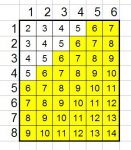Comicsanctum
New member
- Joined
- May 1, 2013
- Messages
- 4
I was wondering if anyone could tell me how I could determine the probability of getting a certain sum or better on multiple dice, each with a different number of sides.?
I was wondering if anyone could tell me how I could determine the probability of getting a certain sum or better on multiple dice, each with a different number of sides.?
No, I was just curious about the method used. I have several dice of different shapes and though I know how to determine the probability if the dice were all the same type, I have no clue where to start from when they are all different shaped.Do you have a specific problem you need to do?
Suppose one die has N sides numbered n=1-N and another has M sides numbered m=1-M. Since the two dice are independent events, probabilities multiply:No, I was just curious about the method used. I have several dice of different shapes and though I know how to determine the probability if the dice were all the same type, I have no clue where to start from when they are all different shaped.
So, if I have a six sided and an eight sided die, it would be (1/6)(1/8)=1/48. Meaning there are 48 different summed results and the odds of getting any one of them is 1 in 48, or about 2%. Is there a way to "count the ways" without actually boxing out the results and literally counting them? Both for an individual number and a set of numbers such as >5?Suppose one die has N sides numbered n=1-N and another has M sides numbered m=1-M. Since the two dice are independent events, probabilities multiply:
1st die, P(n) = 1/N
2nd die, P(m) = 1/M
P(1st=n and 2nd=m) = (1/N)(1/M) = 1/(NM)
Now you have to "count the ways" of getting a specific result. The total possible results of throwing the two dice is NM. Probability is the ratio of the number of ways to get a "success" divided by the the total possible (which is NM).
If you want to work it out for a specific N and M, repost showing us your work.
I would resort to counting - but look out for developing patterns.So, if I have a six sided and an eight sided die, it would be (1/6)(1/8)=1/48. Meaning there are 48 different summed results and the odds of getting any one of them is 1 in 48, or about 2%. Is there a way to "count the ways" without actually boxing out the results and literally counting them? Both for an individual number and a set of numbers such as >5?
So, if I have a six sided and an eight sided die, it would be (1/6)(1/8)=1/48. Meaning there are 48 different summed results and the odds of getting any one of them is 1 in 48, or about 2%. Is there a way to "count the ways" without actually boxing out the results and literally counting them? Both for an individual number and a set of numbers such as >5?

No. This is wrong.So, if I have a six sided and an eight sided die, it would be (1/6)(1/8)=1/48. Meaning there are 48 different summed results and the odds of getting any one of them is 1 in 48, or about 2%. Is there a way to "count the ways" without actually boxing out the results and literally counting them? Both for an individual number and a set of numbers such as >5?
No. This is wrong.
Yes, there are forty-eight possibilities of equal probability, but that does not mean their sums are also equally probable. Let's see why.
.
Jeff is pointing out what you see on the diagonals of the diagram above.
For example, there are 5 ways to get SUM=6.
SUM=6 is 5 times as likely as SUM = 2
So there is no short cut. Ok, I understand the process now. Thank you all for your help!
